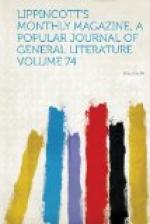Let us step over the Rhine, or rather, alas! over the Moselle, and look up at the tricolor. It floats above a group of structures—one for the general use of the French commission, another for the special display of bronzes, and a third for another art-manufacture for which France is becoming eminent—stained glass. This overflowing from her great and closely-occupied area in Memorial Hall, hard by, indicates the wealth of France in art. She is largely represented, moreover, in another outlying province of the same domain—photography.
Photographic Hall, an offshoot from Memorial Hall, and lying between it and the Main Building, is quite a solid structure, two hundred and fifty-eight feet by one hundred and seven, with nineteen thousand feet of wall-space. Conceding this liberally to foreign exhibitors, an association of American photographers erected a hall of their own in another direction, upon Belmont Avenue beyond the Judges’ Pavilion. This will serve to exhibit the art in operation under an American sun, and enable our photographers to compare notes and processes with their European fellows, who treat under different atmospheric conditions a wider range of subjects. This is the largest studio the sun, in his capacity of artist on paper, has ever set up, as the hall provided for him by the exposition is the largest gallery he has ever filled. Combined, they may reasonably be expected to bear some fruit in the way of drawing from him the secret he still withholds—the addition of color to light and shade in the fixed images of the camera. This further step seems, when we view within the camera the image in perfect panoply of all its hues, so very slight in comparison with the original discovery of Daguerre, that we can hardly refer it to a distant future.
Questions of finance naturally associate themselves with sitting for one’s portrait, even to the sun. A national bank becomes a necessity to their readier solution, be they suggested by this or any other item of expense. Such an institution has consequently a place in the outfit of the Centennial. Here it stands within its own walls, under its own roof and behind its own counter. The traditional cashier is at home in his parlor, the traditional teller observes mankind from his rampart of wire and glass, and the traditional clerk busy in the rear studies over his shoulder the strange accent and the strange face. Over and above the conveniences for exchange afforded by the bank, it will introduce to foreigners the charms of one of our newest inventions—the greenback. This humble but heterodox device, not pleasant in the eyes of the old school of conservative financiers, is yet unique and valuable as having accomplished the task of absolutely equalizing the popular currency of so large a country as the Union. That gap of twelve or thirteen per cent. between greenbacks and gold is no doubt an hiatus valde deflendus—a gulf which has swallowed up many an ardent and confident




